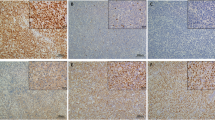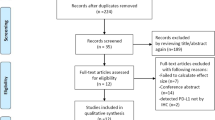Abstract
Cyclooxygenase-2 (COX-2) plays an important role in carcinogenesis, which catalyzes the conversion of arachidonic acid into prostaglandins. P53 is a tumor suppressor gene that contributes to apoptosis and cell cycle control. There is functional interaction between p53 and COX-2, which lead to abrogation of apoptosis and progression of malignancy. To assess the relationship between COX-2, p53 expression and the clinicopathololgic features in SLL and DLBCL. We immunohistochemically examined the expression of COX-2 and p53 in non-neoplastic lymphoid cells, lymph nodal low-grade (50 cases of SLL), intermediate and high-grade lymphomas (100 cases of DLBCL) and their corresponding bone marrow specimens. The expression of COX-2 and p53 was absent in the in non-neoplastic lymphoid cells. In contrast, their expression values increased progressively with the advancing grade of lymphoma (p < 0.001). COX-2 expression was significantly associated with advanced disease stage, high-grade lymphomas, and disease relapse and p53 expression. The p53was detected in 64.5% in patients positive for COX-2. The expressions of COX-2 and p53 proteins, were significantly associated with shorter overall-survival and progression free survival. Here we report up-regulation of COX-2and p53 protein expression in SLL and DLBCL indicating their interactive involvement in the pathogenesis of lymphoma. Our data provide a rationale for further investigation of COX-2 expression in lymphomas for potential prognostic, chemopreventive and chemotherapeutic purposes.



Similar content being viewed by others
References
Jelic S, Jovanovic V, Milanovic N et al (1997) Richter syndrome with emphasis on large-cell non-Hodgkin lymphoma in previously unrecognized subclinical chronic lymphocytic leukemia. Neoplasma. 44:63–68
Matolcsy A, Casali P, Knowles DM (1995) Different clonal origin of B cell populations of chronic lymphocytic leukemia and large-cell lymphoma in Richter’s syndrome. Ann N Y Acad Sci 764:496–503
Traweek ST, Liu J, Johnson RM, Winberg CD, Rappaport H (1993) High-grade transformation of chronic lymphocytic leukemia and low-grade non-Hodgkin’s lymphoma. Genotypic confirmation of clonal identity. Am J Clin Pathol 100:519–526
Brynes RK, McCourty A, Sun NC, Koo CH (1995) Trisomy 12 in Richter’s transformation of chronic lymphocytic leukemia. Am J Clin Pathol 104:199–203
Bea S, Lopez-Guillermo A, Ribas M et al (2002) Genetic imbalances in progressed B cell chronic lymphocytic leukemia and transformed large-cell lymphoma (Richter’s syndrome). Am J Pathol 161:957–968
d’Amore ES, Wick MR, Geisinger KR, Frizzera G (1990) Primary malignant lymphoma arising in postmastectomy lymphedema. Another facet of the Stewart-Treves syndrome. Am J Surg Pathol 14:456–463
Copie-Bergman C, Niedobitek G, Mangham DC et al (1997) Epstein-Barr virus in B cell lymphomas associated with chronic suppurative inflammation. J Pathol 183:287–292
Aozasa K, Takakuwa T, Nakatsuka S (2005) Pyothorax-associated lymphoma: a lymphoma developing in chronic inflammation. Adv Anat Pathol 12:324–331
Sehn LH, Scott DW, Chhanabhai M et al (2011) Impact of concordant and discordant bone marrow involvement on outcome in diffuse large B cell lymphoma treated with R-CHOP. J Clin Oncol Off J Am Soc Clin Oncol 29:1452–1457
Cabanillas F, Velasquez WS, Hagemeister FB, McLaughlin P, Redman JR (1992) Clinical, biologic, and histologic features of late relapses in diffuse large cell lymphoma. Blood. 79:1024–1028
Hodges GF, Lenhardt TM, Cotelingam JD (1994) Bone marrow involvement in large-cell lymphoma. Prognostic implications of discordant disease. Am J Clin Pathol 101:305–311
Robertson LE, Redman JR, Butler JJ et al (1991) Discordant bone marrow involvement in diffuse large-cell lymphoma: a distinct clinical-pathologic entity associated with a continuous risk of relapse. J Clin Oncol Off J Am Soc Clin Oncol 9:236–242
Barisik NO, Bozkurt S, Gumus M et al (2010) Expression and prognostic significance of Cox-2 and p-53 in Hodgkin lymphomas: a retrospective study. Diagn Pathol 5:19
Ohsawa M, Fukushima H, Ikura Y et al (2006) Expression of cyclooxygenase-2 in Hodgkin’s lymphoma: its role in cell proliferation and angiogenesis. Leuk Lymphoma 47:1863–1871
Zhi H, Wang L, Zhang J et al (2006) Significance of COX-2 expression in human esophageal squamous cell carcinoma. Carcinogenesis. 27:1214–1221
Romero M, Artigiani R, Costa H, Oshima CT, Miszputen S, Franco M (2008) Evaluation of the immunoexpression of COX-1, COX-2 and p53 in Crohn’s disease. Arq Gastroenterol 45:295–300
Asproni P, Vignoli M, Cancedda S, Millanta F, Terragni R, Poli A (2014) Immunohistochemical expression of cyclooxygenase-2 in normal, hyperplastic and neoplastic canine lymphoid tissues. J Comp Pathol 151:35–41
Konturek PC, Konturek SJ, Pierzchalski P et al (2002) Gastric MALT-lymphoma, gastrin and cyclooxygenases. Acta Gastro-Enterol Belg 65:17–23
Al-Salam S, Awwad A, Sudhadevi M et al (2013) Epstein-Barr virus infection correlates with the expression of COX-2, p16(INK4A) and p53 in classic Hodgkin lymphoma. Int J Clin Exp Pathol 6:2765–2777
Paul AG, Sharma-Walia N, Chandran B (2011) Targeting KSHV/HHV-8 latency with COX-2 selective inhibitor nimesulide: a potential chemotherapeutic modality for primary effusion lymphoma. PLoS One 6:e24379
Paydas S, Ergin M, Erdogan S, Seydaoglu G (2007) Cyclooxygenase-2 expression in non-Hodgkin’s lymphomas. Leuk Lymphoma 48(2):389–395
Mestre F, Gutierrez A, Ramos R et al (2012) Expression of COX-2 on Reed-Sternberg cells is an independent unfavorable prognostic factor in Hodgkin lymphoma treated with ABVD. Blood. 119:6072–6079
Hsum YW, Yew WT, Hong PL et al (2011) Cancer chemopreventive activity of maslinic acid: suppression of COX-2 expression and inhibition of NF-kappaB and AP-1 activation in Raji cells. Planta Med 77:152–157
Paydas S, Ergin M, Seydaoglu G, Erdogan S, Yavuz S (2009) Prognostic [corrected] significance of angiogenic/lymphangiogenic, anti-apoptotic, inflammatory and viral factors in 88 cases with diffuse large B cell lymphoma and review of the literature. Leuk Res 33(12)
Wun T, McKnight H, Tuscano JM (2004) Increased cyclooxygenase-2 (COX-2): a potential role in the pathogenesis of lymphoma. Leuk Res 28:179–190
Bernard MP, Bancos S, Sime PJ, Phipps RP (2008) Targeting cyclooxygenase-2 in hematological malignancies: rationale and promise. Curr Pharm Des 14:2051–2060
Hussein MR, Haemel AK, Wood GS (2003) p53-related pathways and the molecular pathogenesis of melanoma. Eur J Cancer Prev 12:93–100
Hussein MR, Al-Sabae TM, Georgis MN (2004) Analysis of Bcl-2 and p53 protein expression in non-Hodgkin’s lymphoma. Ann Oncol 15:1849–1850
Hussein MR, Al-Sabae TM, Georgis MN (2005) Analysis of the Bcl-2 and p53 protein expression in the lymphoproliferative lesions in the upper Egypt. Cancer Biol Ther 4:324–328
Li HL, Sun BZ, Ma FC (2004) Expression of COX-2, iNOS, p53 and Ki-67 in gastric mucosa-associated lymphoid tissue lymphoma. World J Gastroenterol 10:1862–1866
Holmila R, Cyr D, Luce D et al (2008) COX-2 and p53 in human sinonasal cancer: COX-2 expression is associated with adenocarcinoma histology and wood-dust exposure. Mutat Res 122:2154–2159
Kardosh A, Wang W, Uddin J et al (2005) Dimethyl-celecoxib (DMC), a derivative of celecoxib that lacks cyclooxygenase-2-inhibitory function, potently mimics the anti-tumor effects of celecoxib on Burkitt’s lymphoma in vitro and in vivo. Cancer Biology & Therapy 4:571–582
Witkowska M, Smolewski P (2013) Helicobacter pylori infection, chronic inflammation, and genomic transformations in gastric MALT lymphoma. Mediat Inflamm 2013:523170
Loong F, Chan AC, Ho BC et al (2010) Diffuse large B cell lymphoma associated with chronic inflammation as an incidental finding and new clinical scenarios. Cancer Biol Ther 23:493–501
Valli R, Froio E, Alvarez de Celis MI, Mandato VD, Piana S (2014) Diffuse large B cell lymphoma occurring in an ovarian cystic teratoma: expanding the spectrum of large B cell lymphoma associated with chronic inflammation. Hum Pathol 45:2507–2511
Sagaert X, Van Cutsem E, De Hertogh G, Geboes K, Tousseyn T (2010) Gastric MALT lymphoma: a model of chronic inflammation-induced tumor development. Nat Rev Gastroenterol Hepatol 7:336–346
Baecklund E, Iliadou A, Askling J et al (2006) Association of chronic inflammation, not its treatment, with increased lymphoma risk in rheumatoid arthritis. Arthritis Rheum 54:692–701
Valli R, Piana S, Capodanno I, Cavazza A (2011) Diffuse large B cell lymphoma associated with chronic inflammation arising in a renal pseudocyst. Int J Surg Pathol 19:117–119
Hoeft B, Becker N, Deeg E, Beckmann L, Nieters A (2008) Joint effect between regular use of non-steroidal anti-inflammatory drugs, variants in inflammatory genes and risk of lymphoma. Cancer Causes Control 19(2):163–173
Katkoori VR, Manne K, Vital-Reyes VS et al (2013) Selective COX-2 inhibitor (celecoxib) decreases cellular growth in prostate cancer cell lines independent of p53. Biotechnic & Histochemistry: Int J Surg Pathol 88:38–46
Piplani H, Vaish V, Rana C, Sanyal SN (2013) Up-regulation of p53 and mitochondrial signaling pathway in apoptosis by a combination of COX-2 inhibitor, Celecoxib and Dolastatin 15, a marine mollusk linear peptide in experimental colon carcinogenesis. Mol Carcinog 52:845–858
Hazar B, Ergin M, Seyrek E, Erdogan S, Tuncer I, Hakverdi S (2004) Cyclooxygenase-2 (Cox-2) expression in lymphomas. Leuk Lymphoma 45:1395–1399
Zweifel BS, Davis TW, Ornberg RL, Masferrer JL (2002) Direct evidence for a role of cyclooxygenase 2-derived prostaglandin E2 in human head and neck xenograft tumors. Cancer Res 62:6706–6711
Hosomi Y, Yokose T, Hirose Y et al (2000) Increased cyclooxygenase 2 (COX-2) expression occurs frequently in precursor lesions of human adenocarcinoma of the lung. Lung Cancer 30:73–81
Miyata Y, Koga S, Kanda S, Nishikido M, Hayashi T, Kanetake H (2003) Expression of cyclooxygenase-2 in renal cell carcinoma: correlation with tumor cell proliferation, apoptosis, angiogenesis, expression of matrix metalloproteinase-2, and survival. Clinical Cancer Research: an Official Journal of the American Association for Cancer Research 9:1741–1749
Kim MH, Seo SS, Song YS et al (2003) Expression of cyclooxygenase-1 and -2 associated with expression of VEGF in primary cervical cancer and at metastatic lymph nodes. Gynecol Oncol 90:83–90
Ermert L, Dierkes C, Ermert M (2003) Immunohistochemical expression of cyclooxygenase isoenzymes and downstream enzymes in human lung tumors. Clinical Cancer Research: an Official Journal of the American Association for Cancer Research 9:1604–1610
Sharma S, Stolina M, Yang SC et al (2003) Tumor cyclooxygenase 2-dependent suppression of dendritic cell function. Gynecol Oncol 9:961–968
Zhang H, Sun XF (2002) Overexpression of cyclooxygenase-2 correlates with advanced stages of colorectal cancer. Am J Gastroenterol 97:1037–1041
Liu X, Li P, Zhang ST, You H, Jia JD, Yu ZL (2008) COX-2 mRNA expression in esophageal squamous cell carcinoma (ESCC) and effect by NSAID. Clin Cancer Res 21:9–14
Chiarugi V, Magnelli L, Gallo O (1998) Cox-2, iNOS and p53 as play-makers of tumor angiogenesis (review). Int J Mol Med 2:715–719
Gallo O, Schiavone N, Papucci L et al (2003) Down-regulation of nitric oxide synthase-2 and cyclooxygenase-2 pathways by p53 in squamous cell carcinoma. Am J Pathol 163:723–732
Han JA, Kim JI, Ongusaha PP et al (2002) P53-mediated induction of Cox-2 counteracts p53- or genotoxic stress-induced apoptosis. EMBO J 21:5635–5644
Subbaramaiah K, Altorki N, Chung WJ, Mestre JR, Sampat A, Dannenberg AJ (1999) Inhibition of cyclooxygenase-2 gene expression by p53. J Biol Chem 274:10911–10,915
Choi EM, Heo JI, Oh JY et al (2005) COX-2 regulates p53 activity and inhibits DNA damage-induced apoptosis. Biochem Biophys Res Commun 328:1107–1112
de Moraes E, Dar NA, de Moura Gallo CV, Hainaut P (2007) Cross-talks between cyclooxygenase-2 and tumor suppressor protein p53: Balancing life and death during inflammatory stress and carcinogenesis. Biochem Biophys Res Commun 121:929–937
Khalifeh I, Munkarah AR, Lonardo F et al (2004) Expression of Cox-2, CD34, Bcl-2, and p53 and survival in patients with primary peritoneal serous carcinoma and primary ovarian serous carcinoma. Int J Cancer 23:162–169
Hussain SP, Harris CC (1999) p53 mutation spectrum and load: the generation of hypotheses linking the exposure of endogenous or exogenous carcinogens to human cancer. Mutat Res 428:23–32
Author information
Authors and Affiliations
Corresponding author
Ethics declarations
Conflict of Interest
No conflict of interest.
Additional information
Publisher’s Note
Springer Nature remains neutral with regard to jurisdictional claims in published maps and institutional affiliations.
Rights and permissions
About this article
Cite this article
Zaky, A.H., Elsers, D., Bakry, R. et al. Prognostic Value of Accumulative Expression of COX-2 and p53 in Small and Diffuse Large B Cell Lymphoma. Pathol. Oncol. Res. 26, 1183–1190 (2020). https://doi.org/10.1007/s12253-019-00674-5
Received:
Accepted:
Published:
Issue Date:
DOI: https://doi.org/10.1007/s12253-019-00674-5




